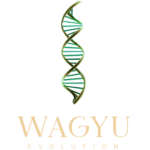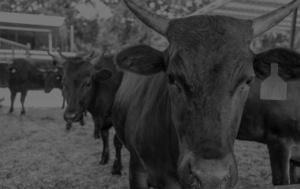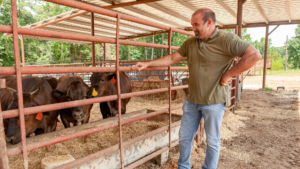Gene Expression Patterns During Intramuscular Fat Development in Cattle
Table of Contents
The amount of fat within the muscle of cattle, known as marbling, affects how tasty and tender the meat is. This fat is influenced by genetics, growth, and diet. Studies show that the development of fat cells in the muscle starts early in life, and it may be possible to predict how much fat an animal will have by examining muscle tissue when it’s young. Research comparing different breeds of cattle found that certain genes related to fat development are more active in some breeds than others. However, the exact timing of marbling in cattle with a genetic predisposition is still not fully understood. To learn more, scientists studied the genetic activity in muscle tissue of two types of crossbred cattle, one known for having high levels of marbling and the other with lower levels.
The production of beef of superior quality holds significant significance within the meat business, wherein the intramuscular fat (IMF) content plays a pivotal role in determining the overall quality of the meat. This study aims to investigate the genetic factors that contribute to the deposition of interleukin-6 (IMF) in cow crossbreeds, with a specific focus on Wagyu Hereford (WxH) and Piedmontese Hereford (PxH) animals. Gaining an understanding of these systems has the potential to yield useful insights aimed at improving both the quality of meat and the efficiency of production.
Considerations for Experimental Design and Analysis
To enhance the dependability and accuracy of the results, the authors carefully chose cattle from each sire breed group that exhibited significant intramuscular fat (IMF) accumulation. Comprehensive statistical modeling was utilized to consider both intra-breed and inter-breed variations. By employing microarray analysis, the authors have successfully discovered prospective candidate genes that are linked to the deposition of intermetallic compounds (IMF). These genes have been further confirmed through the use of quantitative reverse transcription PCR (qRT-PCR).
Studying The Patterns Of Gene Expression During The Early Stages Of Development
The main objective of the study was to investigate the patterns of gene expression in the early stages of development, to gain insights into the start of adipogenesis and lipogenesis. The authors aimed to comprehend the temporal dynamics of IMF deposition in different crossbreeds by examining gene expression patterns at crucial time intervals such as T7 and T25.
The greatest expression of lipogenic genes was detected in WÑH animals at T25, suggesting a substantial buildup of IMF during this developmental stage. The observed temporal pattern of gene expression offers significant insights into the molecular mechanisms behind the accumulation of intermetallic compounds (IMF). It underscores potential markers for the prediction of marbling features.
Examining Mitochondrial Gene Expression and Connective Tissue Structure
In addition, the authors examined differences in the expression of mitochondrial genes and genes associated with the development of connective tissue across several animal species. The findings provide valuable information about the metabolic and structural processes that affect the deposition of IMF and the quality of meat in cattle.
The investigation also encompassed an examination of the involvement of the wingless signaling pathway in the process of adipogenesis, indicating its potential significance in the regulation of interstitial membrane factor (IMF) deposition. Gaining insight into these molecular pathways might provide valuable knowledge for implementing specific treatments aimed at enhancing the quality of beef in animal production.
Analysis and Validation Of Microarrays Using qRT-PCR
By doing a thorough microarray analysis, the authors have successfully identified a total of ninety-seven genes, which includes the expression sequence tags that have not been annotated. These genes were found in different phases of the Longissimus thoracis (LM) muscle. The genes underwent classification based on their various biological activities. The use of qRT-PCR tests provided additional clarity on the notable differences between WH and PÑH animals, which were particularly noticeable at time periods T7 and T25.
Correlation Analysis: Strong positive correlations were observed between the mRNA expression levels of genes related to adipogenesis and lipogenesis, and the intramuscular fat content in WúH animals. However, the association was less noticeable in the P H cohort, suggesting distinct genetic predispositions for the accumulation of fat inside the muscles.
Insights Derived from Early Development Stages: Additional analysis of early developmental stages has shown initial disparities in the expression of crucial genes, namely CEBPB and PPARG, between animals subjected to water-holding and those subjected to pig-holding conditions, as early as T7. The results of this study indicate that animals with marbling potential have an expedited cellular growth of adipocytes.
Conclusion
This work enhances the comprehension of meat quality control and has practical implications for beef production by elucidating the genetic pathways of IMF deposition in cow crossbreeds. The candidate genes and pathways that have been discovered offer significant potential for future research endeavors focused on enhancing beef quality characteristics and enhancing the efficacy of meat production systems.
References
Wang YH, Bower NI, Reverter A, Tan SH, De Jager N, Wang R, McWilliam SM, Cafe LM, Greenwood PL, Lehnert SA. Gene expression patterns during intramuscular fat development in cattle. J Anim Sci. 2009 Jan;87(1):119-30. doi: 10.2527/jas.2008-1082. Epub 2008 Sep 26. PMID: 18820161.



